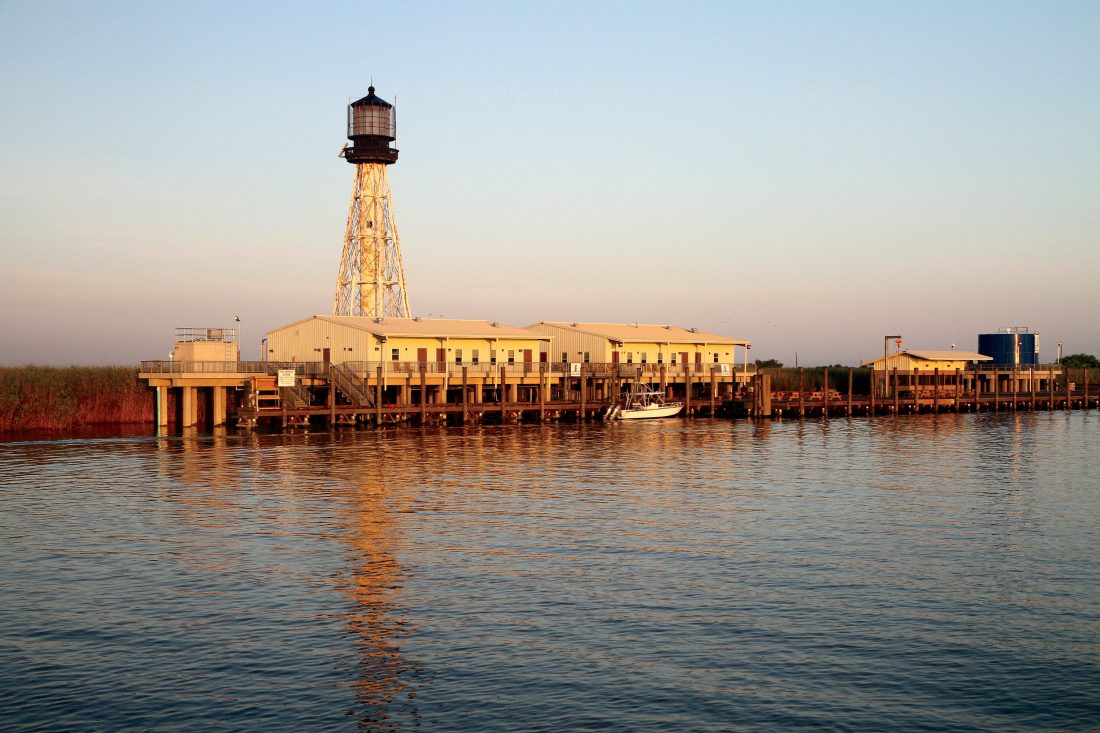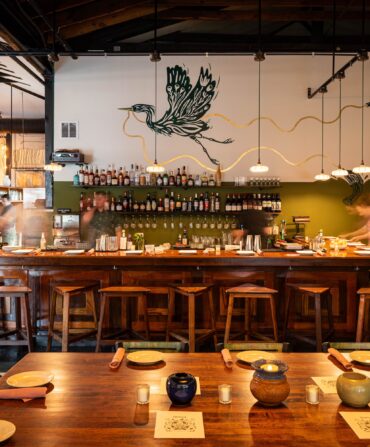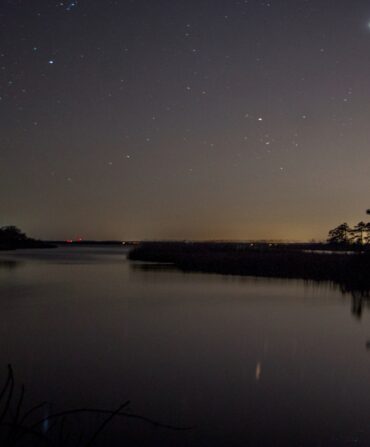We greeted the dawn with a tarpon assault, three rods slow-trolling South Louisiana’s famed Coon Pop lure and a single angler on deck for a quick throw to rolling fish. A sunrise shower gave way to a half rainbow arcing across the sky, and then the wind fell out as if a blessing. The three-foot seas slickened flat, tarpon and spinner sharks rolling and slashing. When the port rod went off, our guide, Jimmy “Gringo” Guerineau, came unglued. “Hit him!” he screamed, as my fishing partner, John Burrell, made a grab for the rod. The tarpon cleared the water fifty yards behind the boat, and I could see the plug fixed in its lip like a stogie. Burrell jammed the rod into his hip as the four-foot-long fish hit the water, but it was too late. The line went slack.
In other circumstances, in another place, such a close call might have ruined the sunrise, but that wasn’t going to happen here. Over the next few hours, we washed away our tarpon sorrows with tidal-creek redfish snookered with shrimp under popping corks. We caught flounder and a twenty-nine-pound black drum. And hours later, when sunset chased us home, we didn’t have far to go. The recently rebuilt Port Eads Marina and Lodges perch like herons on the very edge of the Gulf of Mexico, twenty miles from the end of South Louisiana’s southernmost road. We were met on the wharf with bourbon cocktails. Hot okra fritters waited inside, to be followed, soon enough, by shrimp with a roasted red pepper béchamel sauce.
There is new life at Port Eads, a place with no roads, no mailing address, no permanent residents, and no cell-phone service. It’s new life built on old life, like the South Louisiana marsh itself, out at the end of the Mississippi River, on the edge of the Gulf, at the convoluted, venerated complex of marsh and waterway known as South Pass.
When Hurricane Katrina smashed its way through these marshes ten years ago, it wiped out the historic complex of fishing camps, docks, and a fuel depot that had been a centerpiece of South Louisiana saltwater fishing for more than forty years. In September 1961, the U.S. Coast Guard automated the historic 1881 Port Eads lighthouse and leased the surrounding property to Plaquemines Parish. The parcel came with a 328-foot wharf, a warehouse, and four former Coast Guard dormitories that soon found new purpose as a saltwater fishing outpost. That same year saw the founding of the New Orleans Big Game Fishing Club, and its fifty members adopted Port Eads as their unofficial headquarters. During the club’s first tournament, held over the July 4 weekend of 1962, ninety anglers made their way to the edge of nowhere. For the next forty years, Bertram, Cabo, and Viking sportfishing boats packed the marina during billfishing season. New Orleans’ heavy-hitting business execs showed up in seaplanes, yachts, and helicopters to fish and party in what amounted to a remote summer camp—bunk beds in stuffy rooms, high tides flooding the dining hall—albeit a camp accessed with million-dollar boats.
Katrina took almost everything but the lighthouse. To put it back together—rebuild the wharf, raise two new lodge buildings on stilts, and reconstruct the marina—took $14 million of funding from an unusual consortium of public, private, and nonprofit partners. “There’s nothing like this project,” says Jacque Kuchta, a New Orleans investments manager and businessman who serves as president of the board for the Port Eads Fishing Refuge, the organization established to shepherd the effort. “This is a nonprofit sportfishing center and marina, based on a unique public-private partnership. Our marina and lodges aren’t in business for business, because the bottom line isn’t our ultimate motive. We’re here to make sure that the history of Port Eads continues and to support marine science and education.”
If there’s nothing else quite like Port Eads, there’s certainly little to compare to the region’s angling possibilities. The Mississippi River acts as a conveyor belt of nutrients siphoned from half the continent, delivering unimaginable quantities of fish food to inshore and pelagic predators. Anglers chase redfish and speckled trout year-round. The tarpon bite picks up in October, when the fish cruise South Pass as close as a few hundred yards offshore. The blue-water catch is equally impressive. Just off Port Eads the continental slope comes closer to shore than anywhere else in the Gulf, and dives more than a thousand feet in less than ten miles. Stippled with oil and gas platforms, the water here produces perhaps the most consistent tuna bite in the country—yellowfins are plentiful 365 days a year. The list runs the gamut: Big wahoo. Blue marlin. Sailfish. Mahi.
Port Eads is a fish camp, make no mistake. Lodging is relatively spartan, in dormitory-style rooms with bunk beds. The bathrooms are shared. But Plaquemines Parish pulled in John Burrell’s High Adventure Company—which owns and manages high-end properties from South Dakota to Patagonia—to polish the property’s straightforward government outpost design, and the new approach is telling. You’ll be pampered at mealtime. You can sink down in leather sofas to catch the game on big-screen satellite televisions. The inherently challenging aspects of getting guests to and from such a remote location are approached with a finesse and professionalism honed in places like New Zealand and Zimbabwe.
Honestly, though, you’ve made a wrong turn somewhere if you’re not here for what lies beyond the built environment. The walls of the new Port Eads lodges are plastered with old photos attesting to the riches outside. Most are of marlin hanging with weights painted across their flanks—560 pounds, 502 pounds, 482 pounds. There’s the 1,018-pound blue behemoth caught in 1977 that still holds the state record. A 538-pound tuna. They’re surrounded by windburned anglers in 1970s gym shorts and cutoff blue jeans.
For Guerineau, it’s a museum—and now a living one. “I walk around here with tears in my eyes because I remember all these people, all their stories over all the years,” he says, pointing out old pals and mentors in the black-and-white photos. “Now it’s all back again. There’s just no place like it.”
My first night at Port Eads was a case in point. I rolled in with the setting sun, just as a few boats were pushing back from the Gulf. By dinnertime, the big table in the lodge’s great room groaned with storytellers and stories worth telling. There was John Jackson, past president of Safari Club International, and his wife, Chrissie. The inventor of the Coon Pop, Captain Lance “Coon” Schouest, worked over linguine with two clients who were on a tarpon quest from South Pass to Grand Isle. Another pair of anglers were going DIY, bunking overnight at Port Eads but chasing redfish from their own bay boat.
Suddenly a quartet of scientists from the Louisiana Department of Wildlife and Fisheries walked in for dinner. Howls of greeting and acclamation followed. One of them, Brett Falterman, had crewed on one of the redfish anglers’ big sport yachts back in the day. It was as if the old photographs suddenly came alive. Guerineau was beaming.








